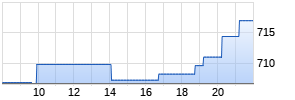
Private Data Exchange Between Businesses Forecasted to Outpace the Public Internet by Nearly 2x in Growth and 6x in Volume by 2020
PR Newswire
REDWOOD CITY, Calif., Aug. 16, 2017
REDWOOD CITY, Calif., Aug. 16, 2017 /PRNewswire/ -- The capacity for private data exchange between businesses is outpacing the public Internet, growing at nearly twice the rate and comprising nearly six times the volume of global IP traffic by 2020, according to the Global Interconnection Index, a new market study published by Equinix that analyzed the adoption profile of thousands of carrier-neutral colocation data center providers and ecosystem participants globally. As business models become increasingly digital, distributed and dependent on the real-time engagement of many more users, partners and service providers, the Index is a powerful new research tool. It highlights how companies are translating digital transformation into action and creating entirely new ways of connecting with their customers, partners and supply chain. The Index will provide an annual baseline to track, measure and forecast the growth of Interconnection Bandwidth, defined as the total capacity provisioned to privately and directly exchange traffic with a diverse set of counterparties and providers at distributed IT exchange points.
Experience the interactive Multichannel News Release here: https://www.multivu.com/players/English/8059151-equinix-global-interconnection-index/

"Some of the greatest technology trends of our lifetime, including mobile, social, cloud and the explosion of data, are creating disruption on the scale of the Industrial Revolution," said Sara Baack, Chief Marketing Officer for Equinix, Inc. "In this new reality, it's a 'scale-or-fail' proposition and companies are succeeding by adopting Interconnection, locating their IT infrastructure in immediate proximity to an ecosystem of companies that gather to physically connect their networks to those of their customers and partners. Interconnection helps fuel digital transformation by supporting multicloud consumption at scale, improving network latency and performance, enabling greater operational control, and reducing security risk."
According to the Index, Interconnection Bandwidth is expected to grow at a 45 percent CAGR to reach 5,000 Tbps by 2020, dwarfing Global IP traffic in both growth (24 percent) and volume (855 Tbps)1. It is also growing faster than Multiprotocol Label Switching (MPLS), the legacy model of business connectivity, by a factor of 10x (45 percent to four percent)2.
Key macroeconomic, technology and regulatory trends that are impacting Interconnection growth include:
- Digital Technology Use, which forces the need to support real-time interactions requiring more Interconnection Bandwidth. According to Accenture, digital technology use is projected to add $1.36 trillion in additional economic output in the world's top 10 economies by 20203.
- Urbanization, which is transforming global demographics and creating a proximity need for digital services concentrated across metro centers globally. More than two billion people are expected to migrate to major cites by 2035, creating as many as 50 major urban metro hubs4 requiring dense Interconnection fabrics.
- Cybersecurity Risk, which expands Interconnection consumption as firms increasingly shift to private data traffic exchange to bypass the public Internet and mitigate against digital threats. By 2020, an estimated 60 percent of digital businesses will suffer major service failures5 as breaches permeate across physical and digital platforms.
- Global Trade of Digitally Deliverable Services, which ushers in a new era of dynamic business processes and demand for Interconnection. Global digital workflows require a global mesh of Interconnected metros to fulfill demand. According to McKinsey6, trade in digitally deliverable services now comprises 50 percent of total services exports globally, with an expected 9x increase by 2020.
Highlights / Key Facts
- The Index provides significant insight into regional differences in how Interconnection is accelerating in different regions of the world. While the U.S. is forecast to have the largest amount of Interconnection Bandwidth, it is the most mature region, and other regions are more rapidly provisioning Interconnection Bandwidth to rival the projected deployment levels in the U.S. The following table outlines projections across all four regions:
| Interconnection Installed Bandwidth Capacity (Tbps) | ||||||
| | 2016 | 2017 | 2018 | 2019 | 2020 | CAGR |
| Region | | | | | | |
| US | 472 | 654 | 913 | 1,275 | 1,795 | 40% |
| EU | 335 | 473 | 681 | 987 | 1,451 | 44% |
| AP | 246 | 355 | 519 | 759 | 1,120 | 46% |
| LATAM | 92 | 154 | 249 | 395 | 626 | 62% |
| Total Region | 1,144 | 1,636 | 2,363 | 3,417 | 4,991 | 45% |
- The Index also forecasts Interconnection Bandwidth by use case for both enterprises and service providers. The largest use case is associated with traditional IT deployment models, in which businesses connect to network providers as an intermediary path to reach business partners and customers. However, the fastest growing use case is enterprises connecting directly to a range of cloud and IT service providers, confirming the transformational shift of IT infrastructure from centralized, enterprise-owned data centers to decentralized, physically dispersed multicloud environments. The following table outlines projections for the top enterprise and service provider use cases:
| Interconnection Installed Bandwidth Capacity (Tbps) | ||||||
| | 2016 | 2017 | 2018 | 2019 | 2020 | CAGR |
| Enterprise Use Cases | | | | | | |
| Interconnecting to Network Providers | 372 | 571 | 880 | 1,341 | 1,986 | 52% |
| Interconnecting to Cloud & IT Providers | 12 | 31 | 80 | 209 | 547 | 160% |
| Interconnecting to Supply Chain Partners | 5 | 9 | 17 | 29 | 45 | 73% |
| | | | | | | |
| Service Provider Use Cases | | | | | | |
| Interconnecting to Network Providers | 537 | 703 | 913 | 1,167 | 1,459 | 28% |
| Interconnecting to Cloud & IT Providers | 30 | 50 | 85 | 145 | 248 | 70% |
- The centricity of digital technology is disrupting how business is done across all industries, forcing companies to invent new, information-centric business models. The Index forecasts the banking and insurance segment will be the largest consumer of Interconnection Bandwidth, as digitization is forcing this industry to support new customer engagement models. Telecommunications is projected to be the second largest segment, with the need to provide coverage in many new locations and support the proliferation of connected devices and sensors. The third largest segment is projected to be cloud and IT services as it provides a critical building block for digital enablement. The following table breaks down the projections by industry:
Mehr Nachrichten zur Equinix Aktie kostenlos abonnieren
(Mit der Bestellung akzeptierst du die Datenschutzhinweise)

Hinweis: ARIVA.DE veröffentlicht in dieser Rubrik Analysen, Kolumnen und Nachrichten aus verschiedenen Quellen. Die ARIVA.DE AG ist nicht verantwortlich für Inhalte, die erkennbar von Dritten in den „News“-Bereich dieser Webseite eingestellt worden sind, und macht sich diese nicht zu Eigen. Diese Inhalte sind insbesondere durch eine entsprechende „von“-Kennzeichnung unterhalb der Artikelüberschrift und/oder durch den Link „Um den vollständigen Artikel zu lesen, klicken Sie bitte hier.“ erkennbar; verantwortlich für diese Inhalte ist allein der genannte Dritte.





